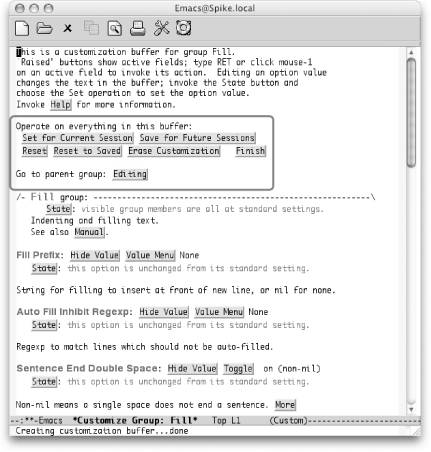Книга: Learning GNU Emacs, 3rd Edition
10.1.2 Common Options
10.1.2 Common Options
At the top of each page in Custom is a common set of buttons shown in Figure 10-2. These options affect the entire buffer.
Figure 10-2. The actions common to all pages in Custom (Mac OS X)

From here you can perform any of the following tasks:
Set for Current Session
Make immediate changes that last for the duration of this session but will be reset the next time you start Emacs.
Save for Future Sessions
Make immediate changes that last for the duration of this session and will also be in place the next time you start Emacs. These changes are stored in your .emacs file.
Reset
Switch back to the previous values (previous to your current changes, anyway).
Reset to Saved
Switch back to the previously saved values. In this case, "saved" means saved for future sessions. If you haven't made (and subsequently saved) any customizations to a variable, this option has no effect.
Erase Customization
This option pretty much does what it says. Any customizations made by Custom, whether for this or future sessions, are removed. Your own personal entries in your .emacs file should remain intact, but it's always a good idea to make a backup before deleting any information.
Finish
Close this buffer and return to the previous customization buffer or back to the buffer from which you launched Custom. Note that you can also press the q key to activate Finish from anywhere in a Custom buffer.
These options are useful when you modify more than one option on a page and want to save them all at once (and in the same way).
Custom corrals options into customization groups, which are set up in a hierarchy of parent and child groups. To go to the parent group for the group you're looking at, choose the button for the parent group in question following the Go to parent group: prompt. To make it easier to find things, a group might have more than one parent. For example, the I18n (internationalization) group has two parents, Environment and Editing, as shown in Figure 10-3.
Figure 10-3. Custom's Go to parent group prompt

Choosing Go to parent group is much like choosing Finish but without closing the buffer. It's a useful option if you're just poking around looking for related variables. We'll show you better ways to find particular features to customize later in this chapter.
- Appendix D. TCP options
- 10.1.5 The Options Menu
- Appendix B. Common problems and questions
- SCTP Common and generic headers
- LOG target options
- Configuration options
- Build Options
- The Menu Options
- Common Configuration Information
- Options Directives
- Using the Common UNIX Printing System GUI
- Two Handy Options




